
Sent: Sunday, May 23, 2004 5:06 PM
Subject: (no subject)
I have a doll from the 50's. I don't know if it has a name but its about 3-4 ft tall. What would it be worth. Sheryl
Dear Sheryl,
Somewhere in the neighborhood of between $1 and $10,000. If you did a little more research, like finding her in a book at the bookstore or on ebay or even the library, and then considered the condition and then looked her up in a price guide, I could tell you if you might expect to get that much or more for her. A few good pictures would help, too.
Thanks for visiting thisolddoll,
Michele
Hi Michele, I was wondering if you could tell me how to repair all over crazing on a compo doll.
I found your website while searching the internet for doll repair sites and I found it very interesting
and informative. I realize there is not simple answer to my question but, any help you can give would
be wonderful.
Thank you so much,
Deb
Dear Deb,
Very long story not so long, think of it like any painted object -
with lots and lots of layers of paint that's cracking and pealing and
lifting. You might be tempted to just peal it all off and paint it
from scratch, but when it comes to a doll, it's better to break all
the rules of good painting and repair the paint. So, the first thing to
do is make sure the paint that's still there is really still stuck to
the surface. Do this by painting the cracks or under the cracks with
Elmer's glue. If the cracks are just hairline and not lifted or buckled,
this can be skipped.
Either way, what you have now is a painted surface with lines that need to
be filled. If the lines are deep and fairly wide, then filling with Milliput
is an option. I mix the two parts (a putty substance) and then roll it into
a thin crayon, dip it in water and scribble over the craze lines.
Then I wipe off the surface so the Milliput is just in the lines.
When the Milliput is hard, I use a sanding pad and sand the surface as
smooth as I can get it.
Next is the airbrush. Probably should have done this first - take the doll
to Home Depot or some other paint retailer and have them mix you a quart of
alkaloid (oil) base semi-gloss paint to match the doll. The paint will be
very thick and you'll want to thin it by about 10% with mineral spirits.
Put the airbrush on the heaviest spray and spray the whole surface. I
have cup hooks under a shelf and I use pipe cleaners or paper clips on the
hooks of each piece to hang it from a cup hook while drying. The first coat
of paint is to resurface the piece. It goes on very thick (simulating the
original process where each piece was dipped in paint and then hung to drip
dry). It will take at least two days for this to dry hard and it needs to
dry hard. The lines will still be visible (probably) so sand smooth, wipe
off the dust with a towel damp with mineral spirits, and then paint again.
It doesn't have to be so thick this time. When it's dry, if you can still
see ridges, then paint again.
If you're working on a face, take a really good picture of the face -
close-up to use for reference when you're repainting the features.
If the craze on the face is very fine, you might be able to get away with
using the paint as it comes - very thick - like liquid makeup and just rub
it into the craze lines. Then wipe it off the good surface. It will look
a lot better and this is very little effort. If there's any chance that
craze concealer or wax has been used on the doll, wipe the surface with
mineral spirits first. Paint won't dry on wax. If it looks like a great
improvement, you might try it again and actually fill the lines with the
paint until it dries level with the rest of the surface. Go easy over the
brows and painted lashes and blush when it comes to rubbing it in - if
you're lucky, these will not be disturbed and you won't have to repaint
them. If you get more paint on them than comes off with a damp paper towel
in mineral spirits, you can use a Q-Tip dipped in mineral spirits to wipe
the paint off of them.
That's about all there is to it. As you do it, you'll discover shortcuts
and get ideas to make it easier but each doll is different with its own
problems and options. One more piece of advice is don't try this on a
really valuable doll as your first project. Get a basket case with lots
of problems including those on your good doll and practice. If it's about
the same flesh tone as the good doll, you can use the same paint that
matched the good doll. When the practice doll looks great (and it will
if you keep at it) you'll have all the confidence and experience you'll
need to tackle the good doll.
So, good luck and thanks for writing!
Michele
Subject: Re: question
Dear Deb - here's your email again with what I'd say to you if you were
here talking to me :)>
I can't tell you how much I appreciate you sharing this info with me. I
have always wanted to try fixing one of these dolls but I thought it was
way to hard and much more complicated. You've made it sound fairly simple.
You're welcome and thanks, I try!
I do have a few more questions though. I have two small (12") comp. dolls that are just cheap no name dolls that I am going to experiment on. First of all, one of the dolls is really dirty and I would like to know how to clean it before I start fixing it.
If you're going to paint the whole doll, the sanding will take off the dirt so cleaning is a bit redundant. If you just want to clean though, I use automobile rubbing compound - check this page of my web site - it shows pictures and descriptions of what I use and how: https://thisolddoll.com/tools.htm The two auto products are the 3rd and 4th items.
One has a spot where the paint behind her bent knee is flaking of. Should I glue the chips back on the doll or just fill the spot where they came off with Milliput?
Either will work. It's easier to glue the old down with elmers and then just fill the cracks, though. Sometimes there's more lifted than not, though and then it's just as well to take it all off and start with a bare core. Then it truly is a matter of paint and sand over and over until you have a totally new surface.
One of the dolls looks like someone replace her rubber band with a bungee cord and the other has her original rubber band. I would like to know if you know where I can get replacement bands when I'm ready to put them back together.
The bungee cord is elastic stringing cord. If it's white or off white with age, it's probably original. Most of the compo dolls from the 30s and 40s had this. The rubber bands weren't used exclusively until the 50s in the hard plastic. When it comes to restringing, either is perfectly fine. I find latex rubber has a better stretch than the cord, but you don't have to worry about the size of the band if you use cord because after the pieces are on the hooks, you can just pull it as tight as necessary, tie a knot, cut off the ends and push the knot inside the body. Bands or cord, unless it's a small doll (14" and under) I use two - arm to arm for one, and head to legs for the other.
You can get stringing cord in various thicknesses from http://www.dollspartsupply.com.
She also has rubber bands - she called them "loops", I think. They look too small but they stretch a lot and the two larger sizes will string a Toni if you use the largest head to legs, and the second size arm to arm.
Rubber bands are cut from latex rubber tubing. I live in Akron, a city built on
the rubber industry and although most of our rubber companies are gone,
there's still companies here that make rubber tubing.
My first job was a dispatcher at B.F.Goodrich and I saw the department
where they were cutting tubing like this into bubber bands for everything
from office supplies to gear belts. So, I have the tubing in the same
sizes that are used to make Dollspart's loops and when I cut it on an
angle, I can make a band as large as I need. I can send you the tubing
and sample bands I cut from it for $5 a foot for the two larger sizes
and $4 a foot for the smaller ones.
The smaller ones are for little dolls - like 8" compo and hard
plastic dolls or for putting the head back onto a shoulder plate
in some cases.
If I should have to repaint the faces, what kind of paint should I use?
I use oil base paint whenever I can but when it comes to painting brows and lashes, I use water color or colored inks. That way I can wipe it off and try again and again until it's perfect. Those two brush strokes on the brows can determine the entire personality of the doll and no matter how perfect the surface is, if those lines look wobbly or at the wrong angle or in the wrong position, it can ruin everything. On a bad day, it can take me an hour to get them right and the little lashes are almost as bad. At least they just take practice, but those brows are an art in themselves. If there's any way you can keep the old ones, do it. You'll save yourself a lot of aggravation. When it's perfect you can mist (very lightly!) with a clear spray to make the watercolor or ink permanent. Can't stress how important it is to just mist - so that it is really just overspray on the face. If you actually wet the face with a spray laquer, it will act like paint remover and bubble up all your
hard work and you'll have to wash it all off with mineral spirits, sand and then start all over!
One more question. One of the dolls has very obvious seem lines going all the way around her body. Can I sand them down before I start repair on the doll. What grit sand paper should I use on the dolls?
Sure! A lot of the dolls were made poorly and you can improve on them. A friend's practice doll, a crudely-made little Horsman got so much attention that it's now better than it ever was when it came from the factory. As for the grit - use whatever gives you the results you want. I don't like sandpaper, though. I can't get a good grip on it and it doesn't bend around curves. I use the sponge sanding pads. They come in many grits - from very coarse - for sanding down seams - to very fine. Get an assortment and use the one that does what you need. Again - scroll down on the tools page (link's above).
Again, I would like to say Thank you, Thank you, Thank you for helping me with this,
And again, you're welcome!
Michele
Dear Michele, a couple of quick questions:
1. What size wig does Cissy take?
I believe it is a size 10 but I wanted to check with you first before ordering.
Yes, the Madame Alexander Cissy takes a 10" wig.
2. I have a Shirley compo. I need to know about what people talk about to stop crazing and oiling the eyes.
I have no clue to this answer.
There is a non-permanent craze concealer that's like makeup to fill the lines. Some dealers use it to make the doll look better for a sale or auction. This is a terrible product because while it looks good for a month or two it's really damaging the doll. The reason is, it's a thick oily substance that never dries and when it gets into the composition under the surface it saturates it. It stops any more humidity from getting into the core but it also collects dust and the lines come back worse than ever. What's worse is that once the lines are filled with this stuff, removing it is next to impossible so the next step is restoration and that's a bigger job because paint won't dry on an oily surface. So the oil-saturated composition has to be dug out and then replaced with filler and then the whole surface has to be repainted. Some concealers are worse than others but I just don't think it's a good thing to use.
Instead of this, there's a much less expensive solution to hairline crazing. Get some oil based, semi gloss paint the same color as your doll. Since you're only filling very fine lines, it doesn't have to be a perfect match so one can will last you forever for all of your dolls. So take your doll to the hardware store and let them scan the color and sell you a quart. Now use this with your fingers like makeup. Blend it into the lines and immediately buff the surface with a good lint-free paper towel (one that's soft and thick like Brawny) so that the features show through the very thin film. This will fill not only the craze lines you can see but the microscopic lines you can't see. Now this will dry and not saturate the core or collect dust and should make the doll look a LOT better than the concealer would.
About eyes - that's is the same class as the concealer but not quite so bad a thing to do. Dropping 3-in-1 oil into the eyes, it fills the cracks and makes them look a lot better - not new, but at least dark. Problem is, again, oil won't dry clear. In a year the dust will have collected into it and the thick oil will be ugly and dull. There won't be anything to do about it because it can't be cleaned out and the iris will have to be replaced - a tedious job but the only real solution to cracked (or blown) eyes.
If you don't want to replace the iris then instead of oil, use Damar Varnish. It's used professionally to restore oil paintings and is available at art stores. Prop the eyes open with toothpicks, lay the doll on her back and put a drop of the varnish in each eye. If it sinks into the eye, put in another drop and another until it fills all the cracks or won't take any more. It will take a couple of weeks to dry so put the doll on its back with the eyes still propped open where it won't be disturbed. The effect will be the same or better than the oil but will dry hard, be permanently shiny and won't collect dust.
Hello Michele:
I love your doll site. I have a question: My hard plastic sweet Sue's eyes
are looking to the outside corners. I have taken off their heads but can't
figure out how to get the eyes to look straight out at me. They seem to move
around a little but whenever I shut and open them they go right back to
looking out the corners. If you know what causes this and how to fix it
please help me.
Thank you
Melissa
Dear Melissa,
It might help to know what these eyes look like when they are out of the head.Here is a picture:
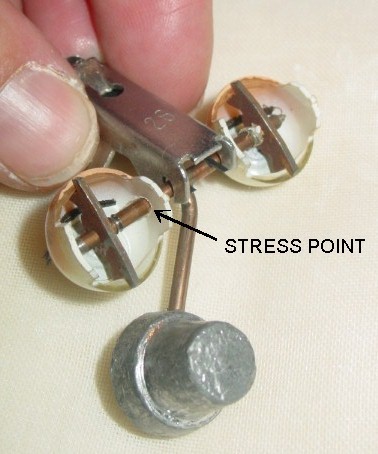
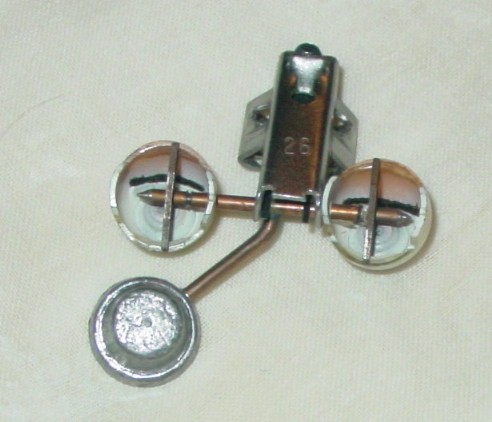
The stress point is the hole through which the T bar goes and it must be tight or the eye will move out of alignment.
Since there are only two points where the T bar is held and one is the center sliding bracket which is made of metal, the other
which is the poastic eyeball gets all the strain and the hole gets enlarged over time. Here is a picture of what this looks like:
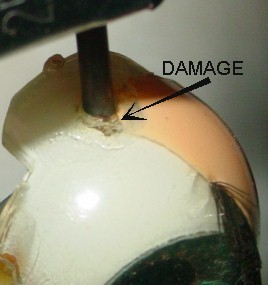
So,the cure is to use a filler inside the eye that will hold the position on the T bar and reinforce the hole in the eye. Here is a set of eyes that have had this done:
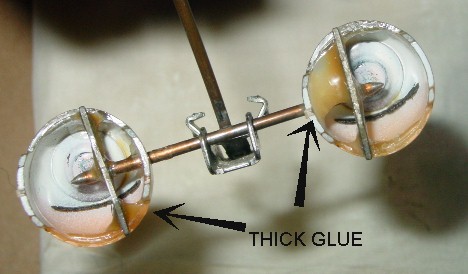
Since this cannot be done while the eyes are in place, you'll have to remove them. The procedure I explained in the hospital section about replacing eye lashes shows you how to do this. Here is the link:
Lash Repair
Michele
hello, my name is Tia and I'm doing a report on the restoration of old
dolls. Could you please tell me the first person who did this and how it was
done, when it was done. And by the way I'm a collector myself.
Thank you,
Tia,
Dear Tia
The first one to restore a doll? People have been fixing their children's
toys ever since children have had toys, and dolls were some of the first toys.
Artist's dolls made for wealthy children were probably repaired by the
artists who made them. I'm sure there was no one person that we can credit
for being the first one to restore a doll.
May I suggest you take another tack on your report and research the dolls
of the centuries - like the ones found in the Egyptian tombs, the ones
played with by European royalty, the ones children had during the ancient
Chinese dynasties.
Or maybe show how dolls through history reflect the values adults wanted to
pass on to their children. Like the beautiful bisque baby dolls and lady
dolls of the wealthy, the rag dolls of the slave children, the corn cob
dolls of the pioneer, the china heads of the 1800s, the Amish dolls that
even today don't have faces because they might encourage children to vanity.
Another aspect is to show the progress of women's roles in society by the
ways dolls were dressed. The professional female - nurse, teacher, model,
secretary, student, mother before the 30s - and then when the World Wars
broke out there came female dolls in uniform. Then in the 50s women were
returned to poodle skirts and debutantes and brides. One of the first
women's libbers when it comes to dolls was Barbie! Once a bubble headed
teenager, through the years she's progressed to what were traditionally
male roles including everything from an astronaut to a race car driver to
a biker.
Finally, a lot can be told about a society's progress in technology by the
materials used in making the dolls. Early mothers made dolls for their
children from what was at hand. The first dolls were probably an animal
pelt wrapped with strips of leather. Native Americans made dolls of
corn cobs and carved wood, heads of dried apples, sculpted clay.
Artists made dolls that were really jointed figurines of bisque or carved
wood, baked clay, molded wax. Manufactured dolls of the mid 1800 of
composition was mixture of wood pulp, rags, glue and other secret
ingredients that were painted and sanded to a smooth, hard surface.
Another favorite material was latex rubber which came along with the
tire industry in about the 1920s. In World War II, plastic was invented
and injection molds were used. After the war, the doll manufacturers
found this new plastic material was great for dolls. The first used a
formaldehyde solvent that leached into the air if the piece didn't happen
to cure properly. Another material was vinyl. The first vinyl didn't hold
it's color or shape and in time turned yellow and had a greasy feel. It was more like human skin,
though and easier to mold and finish. When the vinyl problems were solved in the late 50s,
it was the end of hard plastic and real latex rubber dolls. Today, what we see
in the stores as hard plastic or rubber are really variations of vinyl.
Another idea is the economy of the 20th century.
As the economy dropped, the quality of the dolls was higher. The reason
is that when labor was cheap, more man hours were put into the making of the
dolls - the sewing of outfits, the painting of faces, human hair wigs. When the
economy picked
up and labor became expensive, machines were developed to mass produce dolls
and the clothing. When even this became too expensive to permit a doll to
sell at a price low enough to be a toy for a child, the dolls were no longer
made in this country but imported from countries where labor is still cheap.
<
There's a lot to be learned from dolls and I think you can do better by telling what
can be known rather than looking for what can't!
Good luck and maybe the library would be a great place to start.
Good luck!
Michele
We have several 5" rubber dolls ( at least I think they are rubber) and they
are deteriorating . The rubber is becoming sticky. Is there anything we can
do to stop this and repair them?
Please help
Alysha
Dear Alysha,
Rubber rots over time and there's not much anyone can do to prevent it. Keeping it dry and dusted with talc to absorb moisture in the air helps but once it's started to perish, repair is a lost cause.
Sorry, but that's what makes the surviving dolls more valuable. Of course I could be wrong and there may be some chemist out there who has a miracle treatment.
Good luck with them!
Michele
I recently purchased a Boudoir doll (I think that's
what she is anyways!) and wanted to try and fix her face myself. Her
arms and legs are plastic and in perfect shape but as you can see by the
pictures I have attached with this email, her face has sever cracking and paint
loss. I was wondering how best to restore her? Should I take off all the old
composition first? I've never really tried this before so any advice, if you
have the time to give it, would be greatly appreciated!
Andrea
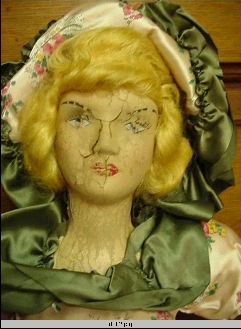
Dear Andrea,
Boy! That's quite a project you have there! Crazing is just splits in the surface paint on the compo. Fixing this isn't hard. Tiny pieces that break off isn't too bad, either. But when the surface has bubbles under it and the entire surface is pealing off, it's a hard fix. As you work on this you'll know why. The first task is to get the head off the doll and he wig off the head. I don't know if this is possible with the boudoir dolls because I've never worked on one. If you can get the head off and the wig off, then you have a decision to make. Generally, I'd say try to stabilize the surface paint by injecting Elmer's Glue under the paint, heating the surface with a hair dryer so the paint becomes soft enough to push down onto the glue and attach once again to the compo core. If this isn't going to work, then you'll have to peal off all the surface paint and put on about twenty or so coats of new paint on the compo. Let each dry thoroughly and lightly sand between coats. When you get it to a smooth surface, airbrush the last few coats with paint exactly the color of the hands. I use oil-based satin finish enamel. Acrylics don't sand as well and can dry in the airbrush. Use the photo you sent me for reference to paint the eyes, mouth, lashes and brows. I use makeup powder blush and eye shadow just like making up a face. To make it permanent, I use the airbrush to give a final coat of clear non-gloss lacquer. I get it in a spray can and just spray a lot of it into the airbrush bottle. The reason I don't spray from the spray can is that the can gives a spray that's too coarse and beads up on the doll's surface.
Now, if you can use the Elmer's to glue down the loose pieces, you can rub oil based paint exactly the same color into the face like applying liquid makeup. Do this several times until the cracks are filled. Lightly sand any ridges. (I use a sanding sponge I bought at Lowes Building Center but if you can't find this, a sponge type emery board/fingernail file is the same thing) Once this is done, touch up the brows, eyes, mouth, and lashes. The advantage to this is that enough of the features will show through the paint to guide you so you won't be painting on a blank face.
Now that the head is almost like new, you can put the wig back on. Use mucilage paper glue from the office supply department. Elmer's makes it and LePages and other brands are out there - the funny shaped bottle with the rubber applicator top - it's shown in the "What I Use" tools section on my web site.
Now put the head back on. Good luck!
BR>
Michele
I have an old squeak baby doll who is 9 1/2 inches tall, she is wearing pajamas with feet and a hood, and holding a little teddy bear. On her back there is a triangle with Jemlee Inc. N.Y. I would just like to do a little research on her but have no idea were to start.HELP.
Well, ya got me. I have looked in a dozen books, old and new and can't find anything on a Jemlee Company. You might get an idea of her value or maybe even find one like her on eBay if you search in dolls on "rubber" or "Jemlee". When you consider that ebay is world wide, if there are any more in the world, one will show up on ebay eventually.
Sorry I couldn't be of more help, good luck!
Michele
Hi Michele, your friend brenda sent me to your web site for answers so i hope
you can help. but before we get started i wanted to say that your web site is
very good!! the way you are willing to share your imfo is excellent. i work
on old compo dolls and i find to that nobody likes to share their secrets. if
they only knew if we don't help out our poor compos today,there will be none
left for the future generations. and i find not to many people restore them
so iam glad you have your sight for the ones that want to but don't know
where to get started.i think you might add the importance of dressing dolls
to original.it would help the others realize that you can fix your dolls but
clothing is also very important part to any of these dolls. the reason i said
this is i sew for my old babies and dress them to look as they were when new,
i have studied clothing and find it just as involving as repair. it is just a
suggestion and you might want to think on it.
now to my question.the doll i am sending you is unmarked,but she has a
backward 13 on her back and 13 on both arms and legs. she is all original.
the dress and bonnet , her green shoes and sock, and she is wearing a shirley
temple slip under her dress. i have guessed and guessed with others to
identify her, but nothing rock soild has come out of it. can you help me find
out who she is, brenda thinks you can and so do i seeing the knowledge you
have by looking at your web site. please let me know either way.thank you so
much for your time and effort, i hope i can return the favor some time.
god bless, kari
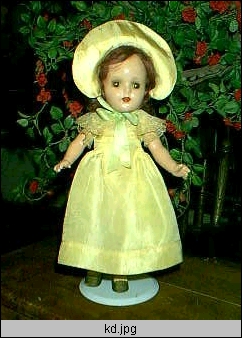
Dear Kari,
I think the same company was making dolls for both Ideal, Vogue and Alexander in the later 30s, early 40s. All the same doll are Ideal's Cinderella with a dimple in her chin, Ideal's Betty Jane or Mary Jane with long braids, the Princess Elisabeth, McGuffy Anna, and Flora McFlimsy for Alexander and a child doll for Vogue. All have human hair wigs and were marked with X in a circle, 13, or no marks at all. Some had their names and the company as marks but many were unmarked except for the X or the 13 and the hang tag on the wrist or sometimes a tag on the clothing identified them.
If your doll's clothes are original (or an exact copy of the original), I'd say she was a Princess Elisabeth. The outfits on the other models were simpler - of cotton with rickrack and pinafores. The clothes for the Princess gave the impression of the little rich girl. Cinderella of course had floor-length grown-up type gowns and there's that dimple in her chin. Your doll's hair color is correct and the length could be curled up onto the neck and around the face? It's hard to tell under the bonnet. What throws me is the brown eyes. Elizabeth had blue or green eyes but that doesn't rule her out as Elizabeth because manufactures used what they had to fill orders. There's even a picture of a marked Elizabeth in a pinafore with a long single braid and pinwheel curls for bangs. So Elizabeth could dress down, but the others rarely dressed up to the Elizabeth standards.
Speaking of dresses, yes I love the research of finding the doll and dressing her in a copy of her original outfit. Long before my hobby evolved into restoration, it was duplicating outfits. The thing is, there are so many seamstresses out there who are so much better than I am in this department that teaching the skill is something I have no business doing. I'll have to leave the how-to details of that for someone else's web page, I'm afraid. I might get into general pattern shapes and making a dress without a pattern but when it comes to actually making the outfits, it's a seat-of-the-pants proposition for me. On the other hand, I know some ladies who do unbelievably beautiful work but can't sew a stitch without a pattern. So maybe a discussion of general pattern shapes and sizing it to the doll would be useful.
Every day I get more ideas for the site and every day I get a task that takes me in a different direction and keeps me away from my dolls. Two weeks ago I took on two dolls from readers to restore. Last week two of my computer clients had system crashes and what was supposed to be finished Monday and today has turned into two two-week projects. The site is usually a demonstration of what I'm doing at the time in the daylight when I can take pictures of it. It might be making a wig, filling craze lines, replacing eyelashes, or whatever. I have the sewing machines set up but lately it's just to make accessories or repair a factory outfit. Someday I'll have some of these dolls finished and ready for outfits and I'll have the time to make them.. at least I hope that day comes soon.
Thanks for the input and I hope I've given you an idea about your doll. The book that has some great pictures of Elizabeth is Composition Dolls 1900-1950 by Mertz. The one with the Vogue dolls is Vogue Dolls by Izen/Stover and the Ideal dolls are pictured in Ideal Dolls by Izen. All of these books are in print and can be seen at Borders or bought on the web from BN.com or Amazon.
Good luck with her - she's a lovely doll!
Michele
Hi Michele! I recently acquired a Raving Beauty, dark auburn with brown
eyes. I don't know what to do with her hair! It's practically in dreadlocks
and I really can't tell what kind of style it had. I've looked at your doll
and several on Ebay, but she doesn't appear to have any bangs or part in her
hair. There is no way for me to get a comb or brush through it without
yanking out a lot of the hair. I have removed her wig pretty much intact.
This hair is much fuzzier than the saran hair that I am used to working
with. Should I just try to seperate the dreadlocks and boil perm her? Any
help would be appreciated. Also, can you think of any other dolls with her
body size and type so that I can watch for an outfit that might fit her. I
know that her clothes were made by "Michele of California" but they seem to
be few and far between.
Thanks,
Michele in California
Dear Michele,
Sounds like your Raving Beauty has a mohair wig. Before you can do anything, see if you can pull a single strand away from the wig without breaking it off. If it pulls apart like cotton candy, it's either rotted or moths have gotten to it. In this case it gets to stay as it is or it can be replaced. One nice thing is that the Raving Beauty often had synthetic or Saran wigs so at least you don't have to find a mohair or human hair wig.
If the wig is in good shape, you can wash it. No, you don't want to put it in boiling water like you would a synthetic. Since you have the wig off the doll, pin it on a styrofoam ball the same size as the doll's head. Now you and wash it with shampoo or Woolite - put the shampoo in warm water in the sink and let the ball float for about ten minutes. Rinse in a few more sinks of clear tepid water and then put cream rinse on it ahd work it through the hair - try to loosen the tangles with your fingers without putting out the hair. Dip the wig in the last sink of clear water and then spread it out sopping wet on a hard surface (a formica table or the flat side of the bathtub works). Now with a very wide toothed comb, start at the very bottom of the hair and try to work up the length to get a lot of the tangles out. You won't get them all out - mohair is fused together short strands so a lot of the tangles are what is holding it together. When you get enough out to be able to separate locks for setting, set them on the smallest curlers you can find (or roll on small pieces of 3/4" tubing from the hardware store.)
I dry these by taking a paper grocery bag and cutting off the corners on the bottom of the bag. Then I put the wig (still on the ball) into the bag and prop it open with a couple of coffee cups. Now turn on the blow dryer and leave it on the floor aimed into the bag. The wig will be close to dry in an hour. Put the ball in one of the coffee cups and forget about it until the next day.
Now that it's dry, you can unwind the curlers and turn the wig inside out. Dot the inside of the wig and around the wig's edges with Elmer's and position on the head. Make sure it's pulled tightly onto the head - no gaps. Arrange the curled hair onto the face so that when the glue dries, you'll be able to style it.
When it comes to styling, I'll often use a wide rubberband or two to hold it down in the general position (like over the crown) while I style it on the ends. Another trick is to put it into a hair net. Hair pins also hold curls in place. Use whatever it takes to whip it into some form of a hairdo. Next I use hair spray to hold it that way. When the spray is dry, pull out the pins, lift off the net and cut the rubberband and pull it out. Once in a while, the hair cut is good enough and the mohair comes out soft enough that all the styling and hair spray aren't necessary. Finally, don't be too concerned if you loose quite a bit of the hair in the comb. There's usually plenty there to work with so loosing a little won't matter.
Think I'll do my next hospital page on wig washing! :)
Good luck, Raving Beauty is such a pretty doll, you'll be proud of the result.
Oh, about the dress. Most of them weren't tagged anyway. She's got a unique figure, though so buying a dress for one off of ebay may be a problem - I've never had any luck buying clothes because the measurements are always sketchy. The best way to find clothes for them is to take yours to a doll show. There are always clothes for sale at them and you can try on the dress before you buy it. Of course, you could see it you can make a dress for her yourself. That's another thing I can cover on the page - making clothes for your dolls without a pattern. I'll have to ask forgiveness of the real seamstresses who see it, though. There are some experts out there who might get a good laugh at the way I don't finish the hidden seams.
Well, good luck and let me know how you make out!
Michele
NOTE: Michele wrote back to tell me she was having success with detangler on the mohair. Thanks for the tip, Michele!
I have an antique doll that I am trying to find information about. She is an
Effanbee, her name is Anne Shirley. I would like to know her history and
value.
Thank you very much for any info. you can send me,
Sherry
Dear Sherry,
Anne Shirley was made in the 40s. Another doll using the same mold was Little Lady. They were made in several sizes - from 14" to 22" (at least that's the largest I've seen.) The wigs were either mohair or human hair, but in 1943 because of the war, the wigs on Anne Shirley (Little Lady) and Sweetie Pie (another Effanbee doll - a baby) were made of cotton yarn. The outfits for Anne Shirley and Little Lady ranged from simple dresses to wonderful gowns. The detail on these dolls was excellent and they were probably the most popular Effanbee dolls of their time. When hard plastic came into use, the Little Lady mold was retired and the Effanbee Honey that was rare in compo became the new Effanbee young lady in hard plastic.
Depending on condition, outfit and size they can range in value from $125 to several hundred dollars.
Here are some pictures of dolls marked Anne Shirley or Little Lady
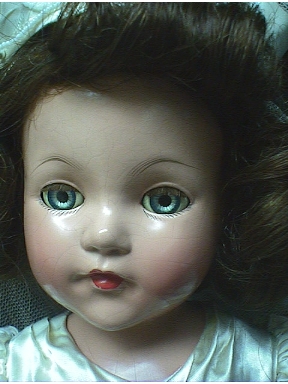
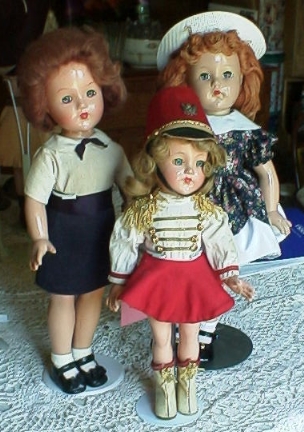
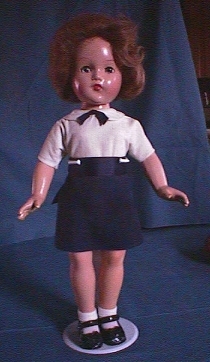
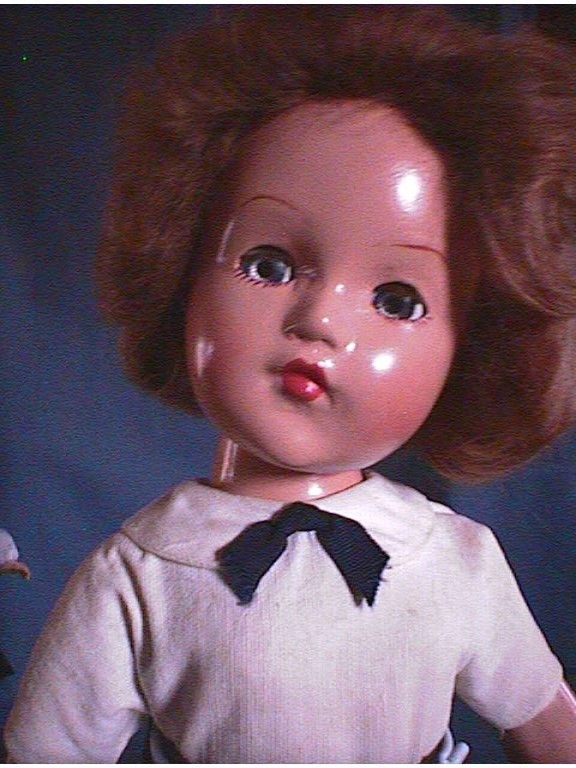
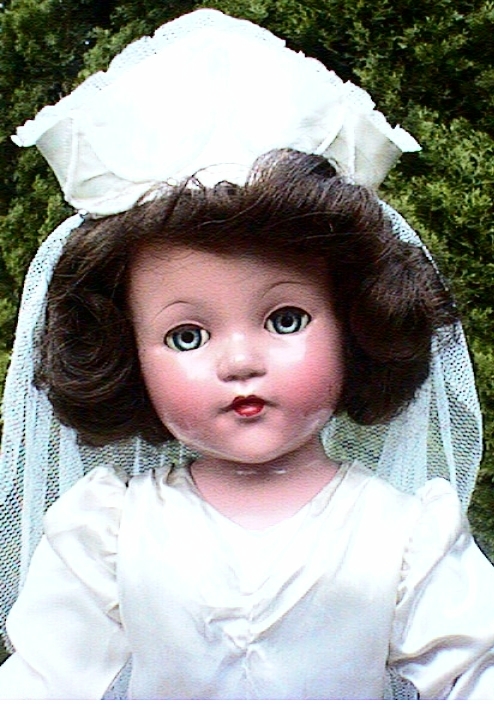
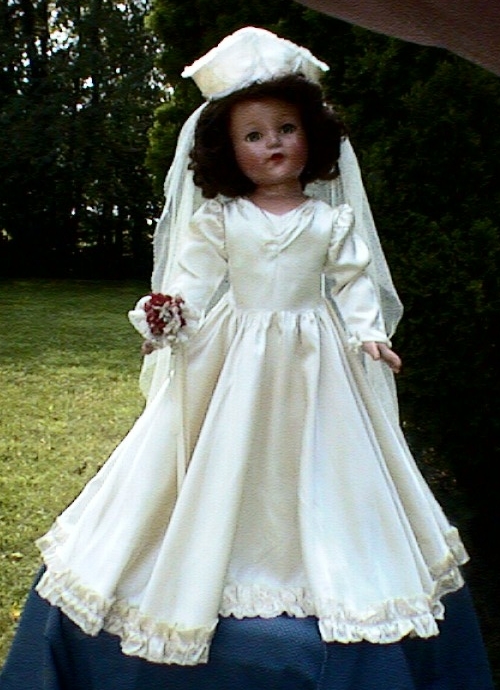
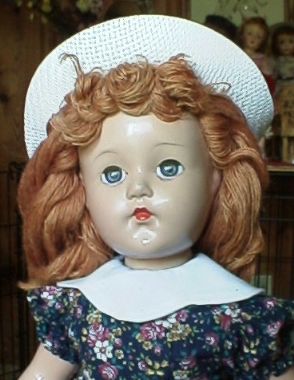
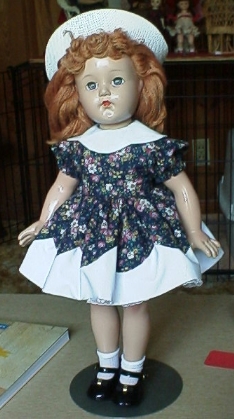
Have you ever seen or heard of the Ricky Ricardo Jr. doll . I'm sure Iremember it as a child of the early '50's.
Yes, I have heard of the Ricky, Jr. doll. From "I Love Lucy" he was also called "Little Ricky". He was made by American Character in 1953. He had a stuffed vinyl
head and had a fully jointed vinyl body. His mouth was open for a bottle and he had sleepy eyes with lashes. The doll was made in two sizes, 12" and 20" and today,
depending on size, condition and clothing values range from $70 to $200.

I have acquired a Betsy McCall that was said to have come from the late 50's.
She is EXACTLY like the other Betsy's that I own in every way, but she does
not have the circle stamp on her back. Do you know why this would be? Were
there any known "knock-offs" of the original 8" Betsy that you know of? Any
clue as to where I can go to find the answers to these questions would be
GREATLY appreciated!
Sue
Dear Sue,
On page 22 of Betsy McCall / A Collector's Guide by Marcie Van Ausdall (a great new book, by the way!) the end of the first paragraph explains that the dolls sold by Montgomery Ward and Sears were in plain boxes instead of the printed boxes American Character was using. These dolls were still Betsy McCall by American Character but weren't stamped on the back. There's no mention of this affecting the value of the doll. As for knockoffs or the AC Betsy, I don't think there ever were any. If there had been, there would be substitute, factory-made clothing and accessories available and I've never seen any!
So I guess it's safe to say if it looks like a Betsy, it's a Betsy!
Subject: Marilyn Monroe
could you please tell me the price range of this doll?
Marilyn Monroe
My doll reference is limited to dolls of the 30s, 40s, and 50s. Sorry, but there is nothing in my books about a Marilyn Monroe doll. I know there have been several made in recent years but I have no idea what their current values would be. Perhaps if you did a search on eBay past auctions for Marilyn Monroe in the Dolls category, you could get an idea.
Recently, I purchased a Toni with a broken foot. When she arrived, not only was her foot broken, but she had a terrible odor that did not wash away. She is also very pale. She looks almost white, and yet she still has pink blush on her knees and hands. I have never seen anything like it.
Could you please tell me the best glue to use to fix the foot. Is there any way to get rid of the odor and bring back some color? Enclosed are some pictures. Two of the pictures she the pale leg next to my Toni's leg. Thank you for your time.
P.S. What do you use for clamps when glueing?
Thanks again,
Patricia
Dear Patricia,
Sounds like you have quite a project there. The plastic odor is something that can't be cured entirely. It's part of the early plastic - an unstable compound that's loosing its solvent. I've learned to live with it unless it's really bad. Then the doll goes into a transparent display case. Some have told me that it can be lessened by scrubbing with Fantastic, letting it dry outside, and putting drier sheets inside the doll. As for the broken foot - is it a clean break? Do the pieces fit together well? If so, you can use a few drops of super glue and hold the pieces together tightly for two minutes. Use epoxy putty (Plastic wood - see my web site) to fill in any cracks and then sand smooth. Finally you'll need an airbrush to paint the leg - making sure you match the exact color of the other leg. If it's a stress break or a split, this won't work.
I couldn't see your pictures, for some reason, the download was zipped into a large file that unzipped into text files. If you would like to try again, please send only one file per email. Between the browsers and the services, several files sent at a time usually doesn't work.
Hope this helps a little,
good luck!
My great grandmother has a doll that she refers to as a Big Boy doll. Big
Boy being the name of it. Unfortunately she doesn't know much more than
that. If you have any information that would help us it would be appreciated.
God Bless,
Joshua
Dear Joshua,
"Big Boy" doesn't give me much to go on. It would help if I knew how old your grandmother is and if she got is when she was a girl, what the doll is made of, if it has hair, is it mohair or human or synthetic. How large is the doll? How is it dressed? Are there any marks on it? A trade mark or name?
If your grandmother is in her 50s or 60s she may have a doll that was the trademark of Big Boy restaurants. He would be fat with black hair with an early Elvis Presly haircut. His pants might be black and white check with suspenders and a T-shirt. I've attached a picture of the current Big Boy doll. If the one your grandmother has is old, it will look different, but the similarities may be enough to ascertain his identity.

If it's not anything like your grandmother's doll, then I'll need some more details and if at all possible, a picture.
QUESTION
ANSWER
QUESTION
ANSWER
Hi Michele I have a terri lee that has a seam coming loose on her neck. What kind of glue can I used to repair it.
Shirley
It depends on the severity of the seam split. If you can push it back together and hold it shut, Super Glue might to the job. Take the doll apart so you're only dealing with the piece that needs repaired.
The trick to using Super Glue is to hold the two pieces together very tightly and very still. Super Glue actually melts plastic a little to form a true bond. If you can almost get it closed with your hands but not hold it tightly enough to let the Super Glue make the bond, try a small cloth-covered vice. Apply the pressure gradually and stop as soon as the seam is truly closed. Too much pressure applied too quickly could crack the piece. Applying heat from a hair drier while tightening the vice might help.
If Super Glue doesn't hold or if you can't even force the two sides of the seam together, then it's time to decide if it's really bad enough to take more drastic measures. This will involve filling the split with plastic filler, sanding, and airbrushing. Generally, unless the split is so wide that it's distracting to the doll's appearance I'd leave it alone. The doll is about 50 years old and the plastic she's made of is from a time when plastic was state-of-the-art technology. These small flaws in the dolls are part of their charm!
I have a 50-'s doll sort of like a rubber vinyl.... her hair is
all matted... could I wash it or something to make it seem fresheer and
cleaner without ruining it??
First we have to know what the doll is made of. From the 50s it could be compo which is like a cross between paper mache and wood filler - which is about what it is. Each company had its own secret recipe for composition but it always included shredded cloth and sawdust that was mixed with some kind of glue into a paste that was pushed into the molds. When it hardened, it was sanded and painted and sanded and painted and sanded and painted and ... Eventually the surface looked like either bisque if a matte finish was used or china if a semi gloss finish was used. It really looked like painted wood, actually. Fine detail was not possible with compo, so the doll will have fat fingers. In any event, if your wig is on this type of doll, it has to be removed before you can wash it, if you can wash it.
Another material 50s dolls were made of is hard plastic. Hard plastic dolls generally don't weigh as much as compo dolls of the same size. If your doll is strung, you can look inside the head and see how thick the material is. It it's a quarter to half inch thick, it's compo. If it's thin, 1/8" or so, it's hard plastic. Hard plastic dolls have a chemical smell to them - usually very slight, but sometimes a really distinct odor. This is because the early plastics weren't stable compounds. Hard plastic is practically indestructible, however so the wig would not need to be removed before washing - again, if it can be washed.
Then there's vinyl. This is softer than plastic or compo. If you tap a fingernail on the surface, instead of a "click", you'll hear a "thunk". It also is possible to press a fingernail into the vinyl. Early vinyl was also not a stable compound and over the years much of it turned yellowish and has a greasy surface. Some of these dolls had wigs but most had hair rooted directly into the scalp. The rooted hair was also usually saran or some other synthetic, so it can definitely be washed and carefully brushed out with a wire wig brush.
Finally there's rubber. An old rubber doll is heavy for its size. The rubber may have hardened over the years and become brittle, but it will not be as hard as compo or hard plastic. There will be at least very fine crazing on the surface of any old rubber doll. You may need a magnifying glass to see it, but it will be there. This is the kind of crazing you see on even an old rubberband, as opposed to the crazing you see on compo dolls which is cracking paint. Wigs on these dolls were rare, and moisture in rubber will cause it to rot, so if you have a rubber doll with a wig, remove it before trying to wash it.
So, if it's hard plastic or vinyl, the wig can stay on the doll. Otherwise, remove the wig.
Now, what is the wig made of? If it's synthetic or human hair, it can be washed. If it's mohair, it can be washed, too, but with a LOT more trouble. One way to tell is to take a strand of the hair and hold it over a flame. If it melts, it's synthetic. If it burns to a fine ash, it's mohair or human hair. If you were able to pull a complete strand out of the wig and it burned to an ash, it is human hair. If the strand pulled out was like pulling a fiber out of a shetland sweater and it broke or is very fine and kinky, it's mohair.
Warning -before soaking any wig, make sure the wig base is stable. If it's frayed, thin, or rotting, do not soak the wig - the base will shrink up or just fall apart and you'll just have a mass of hopelessly tangled hair. Now, assuming the wig base is in wonderful condition, you can wash synthetic or human hair - just use a mild shampoo or Woolite and soak the wig for a few minutes using luke warm water. Rinse several times and I use a cream rinse or fabric softener in the last rinse. This makes it easier to brush out with the wig brush. To brush it out, work on it very wet on a flat table if the wig is off the doll. Start at the ends and hold the hair so you're not tugging on the wig base. Work your way up to the wig base. Once all the tangles are out of the wig, use drinking straws or cut pieces of plastic tubing you can find at the hardware store for curlers. If the hair is too stiff to wrap neatly around the curlers, use tissue squares on the ends like they used to use on home permanent kits. Once the hair is all rolled up, if the wig is synthetic, hold the wig in the live steam from a boiling tea kettle. If the hair is human, use moose, hairspray, or daub on setting lotion or gel. This will hold the set. Once the wig is completely dry, carefully take out the bobby pins and pull out the curlers. You'll have a nice clean head of perfect curls. Style if you like or just arrange the curls with your fingers.
If the wig is mohair, you may realize this is a lot of work and the wig may be damaged if you try to wash it. I have washed mohair in the same manner as human hair in the above explanation. All I can say is that it was so bad that I was willing to risk it, and in all but one case, it's been delightful to have clean, soft, fluffy mohair on my doll. The one case that didn't work was bad enough, though that I was made to realize how lucky I was with my success stories. First, you have to know that mohair is not a single strand in a wig base. It is several strands fused together into a single strand from a wig base. Depending on this fusing process, the joins may come apart when the wig is wet or when an attempt is made to brush out the mats even from dry mohair. If you do decide to risk soaking a mohair wig, when it's wet, pin it to a Styrofoam ball the size of the doll's head. Now use a wooden tooth pick to gently undo each of the knots in the matting. You'll probably find quite a lot of the strands are coming out of the wig. Save these. Don't try to get out all of the tangles, remember most of those knots are what's holding the wig together. Once it's hanging down it's full length instead of totally matted up, let it air dry. When it's dry, you can use a soft boar's bristle brush to work from the bottom and brush out some more of the tangles. Be sure to hold the hair to avoid tugging on the wig base. Now use a darning needle and stitch any of the strands that came out back into the wig to fill in any thin spots. Now you can spray it with water and set as explained for synthetic or human hair.
If all this is too scary, and I don't blame you because it is risky, you can use the toothpick on the dry, dirty wig and gently pull the individual strands away from the mats. If you're patient, you can actually untangle and separate the strands to a point where the wig can be brushed or even set. If you want to really freshen it, a safe way is to dampen two wash clothes in water with a little fabric softener. Hold the detangled strands on one cloth and pat with the other. Now set that strand on the tubing and secure with a bobby pin. Get the next lock of hair, pat between the clothes, roll up on a piece of tubing and secure with a bobby pin by putting it into the adjacent curler and this one. Once it's dry, take out the curlers and glue the wig back on the compo doll. About wig glue - I use Elmers for hard plastic dolls with synthetic wigs. I use mucilage (old fashioned paper glue from the office supply store) to glue synthetic wigs back on compo or plastic. This mucilage will dry out and crumble when the handle of a spoon is poked under the wig and makes getting the wig off again in a few years a lot easier than if white glue had been used. This is also the best method I've found to remove a mohair wig from the compo doll. Pulling on it can tear the wig base.
So, the answer to your question is yes, you can probably wash or clean or at least freshen you doll's wig. The general rule when working with old dolls is to do as little as possible. So try just lifting the hair with the toothpick and gently brush the style with a soft brush or arranging with a wide-tooth comb. Anything else when it comes to a wig on compo requires the wig to be removed. Never have a wet wig on compo - compo is water soluble.
Return to Front Page


















